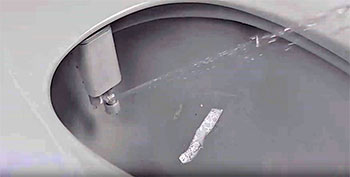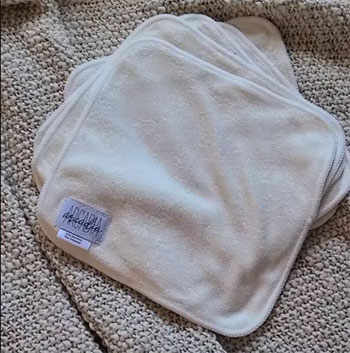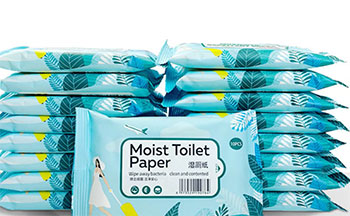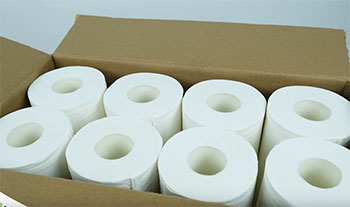In our quest for cleanliness and comfort, flushable wipes have become a popular bathroom staple. But with growing concerns about their environmental impact and potential plumbing problems, many of us are seeking alternatives.
Let’s dive into the world of wipe alternatives, exploring options that are kinder to our pipes and the planet.
The Problem with Flushable Wipes
Before we explore alternatives, let’s address the elephant in the bathroom: flushable wipes aren’t as flushable as we’ve been led to believe. Despite their name, these wipes can cause major headaches for homeowners and municipal sewer systems alike.
You might be thinking, “But the package says they’re flushable!” Here’s the catch: while they might make it down your toilet, they don’t break down like toilet paper. This can lead to clogs in your pipes, septic systems, and even contribute to massive “fatbergs” in city sewers. Not to mention, they’re often made with plastic fibers that can harm aquatic life when they eventually reach our waterways.
So, what’s a clean-conscious individual to do? Fear not! We’ve got a treasure trove of alternatives that’ll keep you feeling fresh without flushing your money (and the environment) down the drain.
Bidet: The Bottom-Cleansing Revolution
Pros:

- Superior cleaning power
- Reduces toilet paper usage
- Environmentally friendly
- Cost-effective in the long run
- Customizable settings for comfort
Cons:
- Initial installation cost
- Requires some getting used to
- May need electrical outlet nearby
Let’s start with the crème de la crème of tush-cleansing technology: the bidet. If you’ve never used one, you’re in for a treat (and possibly a surprise). Bidets use a targeted stream of water to clean your nether regions, leaving you feeling squeaky clean without a wipe in sight.
Modern bidets come in all shapes and sizes. You’ve got your basic bidet attachments that can be easily installed on your existing toilet, fancy electric bidet seats with heated water and air-drying functions, and even portable travel bidets for the clean freak on the go.
The pros are pretty impressive. Bidets offer a thorough clean that wipes can’t match. They significantly reduce your toilet paper usage, which is great for both your wallet and the environment. Many users report feeling cleaner and experiencing less irritation compared to using wipes or toilet paper alone.
But let’s be real – bidets aren’t perfect. The initial cost can be a bit of a shock, especially if you’re eyeing one of those top-of-the-line models with all the bells and whistles. There’s also a learning curve. Your first bidet experience might leave you feeling a bit… surprised. And if you’re renting or don’t have an electrical outlet near your toilet, installation could be tricky.
Despite these minor drawbacks, many bidet converts swear they’ll never go back to the old ways. It’s like upgrading from a flip phone to a smartphone – once you experience the difference, it’s hard to imagine how you lived without it.
Reusable Cloth Wipes: The Eco-Warrior’s Choice
Pros:

- Extremely eco-friendly
- Cost-effective over time
- Soft and gentle on skin
- Customizable (make your own or choose from various materials)
Cons:
- Requires washing after use
- Initial investment in multiple wipes
- May not be convenient for on-the-go use
- Some people might find the concept unappealing
If you’re ready to take your eco-game to the next level, reusable cloth wipes might be your new best friend. These soft, washable cloths are the ultimate sustainable alternative to disposable wipes.
The concept is simple: use, wash, repeat. You can buy pre-made cloth wipes or go the DIY route by cutting up old t-shirts or flannel sheets. Keep a stack by the toilet, use as needed, and toss them in a small wet bag until laundry day.
The environmental benefits are obvious – you’re creating zero waste and reducing your reliance on disposable products. Your wallet will thank you too, as the initial investment pays off quickly compared to constantly buying disposable wipes.
Cloth wipes are also incredibly gentle on sensitive skin. You can choose soft, natural materials like bamboo or organic cotton, and you won’t have to worry about harsh chemicals or fragrances irritating your delicate areas.
Now, let’s address the elephant in the room – the ick factor. Some folks might balk at the idea of washing used bathroom wipes. But think about it – we wash our underwear without a second thought, right? With proper washing (hot water and a bit of bleach or vinegar), your cloth wipes will be perfectly hygienic.
The main downside is the extra laundry. You’ll need to wash your wipes every few days, which means a bit more work and water usage. And while they’re great for home use, carrying around used cloth wipes when you’re out and about might not be everyone’s cup of tea.
Moistened Toilet Paper: The Familiar Upgrade
Pros:

- Easily available
- Familiar format
- More biodegradable than flushable wipes
- Convenient for travel
Cons:
- Still creates waste
- Can be more expensive than regular toilet paper
- May not be as durable as other alternatives
- Some brands may still contain harmful chemicals
If you’re not quite ready to jump on the bidet bandwagon or commit to cloth wipes, moistened toilet paper might be your happy medium. These are essentially regular toilet paper that’s been pre-moistened, offering a bit more cleaning power than dry paper alone.
The big advantage here is familiarity. It’s the same toilet paper you know and love, just with a bit of extra oomph. They’re widely available in most stores, making them an easy switch from flushable wipes.
Moistened toilet paper is generally more biodegradable than flushable wipes, breaking down more easily in water. This means less risk of clogs and environmental damage. They’re also super convenient for travel or on-the-go use.
However, they’re not perfect. While better than flushable wipes, they still create waste and often come in plastic packaging. They can also be pricier than regular toilet paper, and some brands may contain chemicals or fragrances that could irritate sensitive skin.
Durability can be an issue too. Moistened toilet paper tends to be softer and more prone to breaking apart during use compared to sturdier flushable wipes. You might find yourself using more to get the job done.
DIY Wipe Solutions: The Crafty Cleaner’s Approach
Pros:
- Customizable to your preferences
- Cost-effective
- Control over ingredients
- Reduces plastic waste
Cons:
- Requires time and effort to make
- Need to store properly to prevent drying out or mold growth
- May not be as convenient as store-bought options
For the DIY enthusiasts out there, why not try making your own wipe solution? This approach allows you to create a custom cleansing experience while controlling exactly what goes onto your sensitive areas.
The basic idea is to create a gentle cleansing solution that you can apply to regular toilet paper as needed. A simple recipe might include water, aloe vera gel, witch hazel, and a few drops of gentle essential oil like lavender or tea tree.
Store your solution in a small spray bottle or pump dispenser next to the toilet. When nature calls, simply moisten some toilet paper with your homemade solution, and voila – instant upgraded wipe!
The pros are pretty sweet. You have complete control over the ingredients, avoiding harsh chemicals or irritants. It’s incredibly cost-effective, and you’ll significantly reduce your plastic waste compared to buying pre-packaged wipes.
On the flip side, it does require a bit of effort to mix up your solution and remember to restock. You’ll need to be mindful of proper storage to prevent your solution from growing mold or bacteria. And while it’s great for home use, it might not be the most convenient option for travel or public restrooms.
Shower or Sink Rinse: The au Naturel Approach
Pros:
- Free to use
- Thorough cleaning
- No additional products required
- Completely zero-waste
Cons:
- Not always convenient or accessible
- Requires changing habits
- May not be suitable for public restrooms
Sometimes, the simplest solution is the best. If you’re at home and have the time, why not just hop in the shower for a quick rinse? Or, for a less involved option, use your sink and a washcloth for a targeted clean.
The benefits are pretty clear. It’s free, uses no additional products, and gives you a thorough clean that’s hard to beat. Plus, it’s completely zero-waste – just you and water doing what nature intended.
Of course, this method has its limitations. It’s not always convenient, especially if you’re in a hurry or using a public restroom. It requires a bit of a habit change, and let’s be honest – not everyone wants to hop in the shower every time they use the bathroom.
But for those times when you’re at home and have a few extra minutes, a quick rinse can leave you feeling fresher than any wipe ever could.
Bamboo Toilet Paper: The Sustainable Wiper’s Delight
Pros:

- More sustainable than traditional toilet paper
- Soft and strong
- Biodegradable
- Often comes in plastic-free packaging
Cons:
- Can be more expensive than regular toilet paper
- May not be as widely available
- Still creates waste, albeit more sustainably
While not a direct alternative to flushable wipes, bamboo toilet paper deserves a mention in our quest for a more sustainable bathroom routine. This eco-friendly option is making waves in the world of personal hygiene.
Bamboo toilet paper is exactly what it sounds like – toilet paper made from bamboo fibers instead of traditional wood pulp. Bamboo grows incredibly fast and requires less water and no pesticides, making it a more sustainable choice.
The texture is surprisingly soft and strong, often matching or exceeding the quality of traditional toilet paper. It’s fully biodegradable and often comes in plastic-free packaging, further reducing your bathroom’s environmental impact.
The main drawback? Cost. Bamboo toilet paper tends to be pricier than its traditional counterparts. It’s also not as widely available, though this is changing as more people seek out sustainable alternatives.
While it may not provide the same moist cleaning power as flushable wipes, pairing bamboo toilet paper with one of our other alternatives (like a bidet or DIY spray) could be the perfect eco-friendly combination for your cleanest, greenest bathroom routine yet.
Also Read: DUDE Wipes Vs. Cottonelle Wipes: A Comprehensive Comparison
FAQ: Flushing Out the Facts
The “best” alternative really depends on your personal preferences and situation. However, bidets are often considered the top choice for their superior cleaning power, environmental benefits, and long-term cost-effectiveness. They provide a thorough clean without creating any waste. If you’re not ready for a bidet, reusable cloth wipes or a combination of bamboo toilet paper with a DIY moistening solution can be excellent alternatives.
Despite marketing claims, the truth is that no wipes are truly safe to flush. Even wipes labeled as “flushable” don’t break down quickly enough in water and can cause clogs in your plumbing or issues in sewage treatment plants. It’s best to avoid flushing any type of wipe, regardless of what the packaging says. If you must use disposable wipes, always throw them in the trash rather than flushing.
There are several alternatives to wet wipes:
Bidets or bidet attachments
Reusable cloth wipes
Moistened toilet paper
DIY wipe solutions (water, aloe vera, witch hazel mixture on regular toilet paper)
A quick shower or sink rinse
Bamboo toilet paper (paired with water or a gentle moistening solution)
Each of these options has its own pros and cons, so you might want to experiment to find what works best for you.
No, plumbers generally do not recommend flushable wipes. In fact, many plumbers actively discourage their use. Flushable wipes are a common cause of clogs and sewer line backups, leading to expensive repairs.
Plumbers often report pulling out massive clogs of supposedly “flushable” wipes from pipes and sewage systems. They typically recommend sticking to toilet paper only or exploring alternatives like bidets if you want a more thorough clean.
Conclusion: Wiping Out Bad Habits
As we’ve explored the world of flushable wipe alternatives, one thing becomes clear: there’s no one-size-fits-all solution. The best choice for you will depend on your personal preferences, budget, and lifestyle.
Whether you decide to embrace the bidet revolution, go old-school with reusable cloth wipes, or mix and match different options, the important thing is that you’re taking steps to reduce your environmental impact and protect your plumbing.
Remember, change doesn’t have to happen overnight. Start with small steps – maybe try a bidet attachment or experiment with a DIY wipe solution. As you find what works for you, you’ll be contributing to a cleaner planet, one wipe at a time.
So go forth, eco-warriors and clean freaks alike! Your bum, your pipes, and Mother Earth will thank you for making the switch from flushable wipes to these planet-friendly alternatives.
